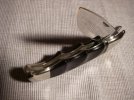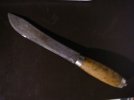Fällkniven specifically identifies laminated steels they use as having a 20 percent advantage compared with the same blade of a single material. I am unclear what the advantage is, though. Other than raising blade cost, please identify advantages and disadvantages of:
- Laminated steel compared with single steel blades.
- Damascus [forged??] steel compared with single steel blades.
***
Have there been valid tests that verify claims either way?
- Laminated steel compared with single steel blades.
- Damascus [forged??] steel compared with single steel blades.
***
Have there been valid tests that verify claims either way?


